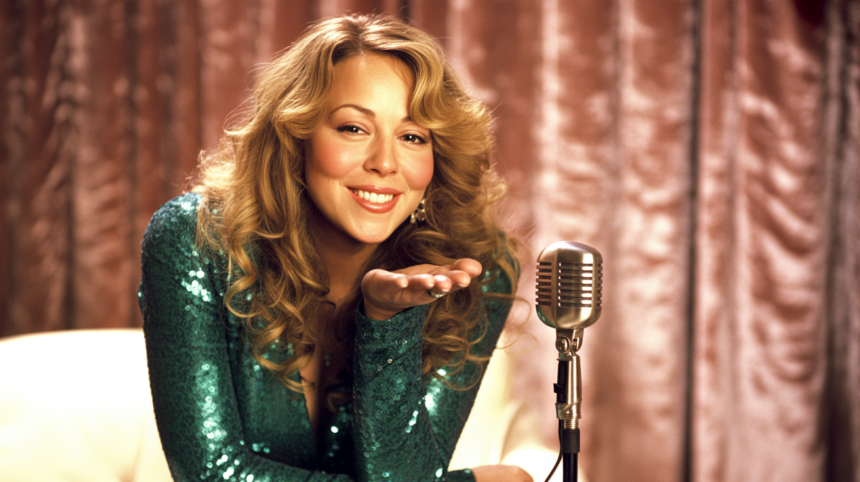The 1990s weren’t just a decade of grunge rock and boy bands—they were the Mariah Carey 90s. With her five-octave range, record-breaking singles, and genre-defining albums, Mariah was the blueprint for pop stardom. She was the charts, not merely one of them.
For anyone who grew up in that era, Mariah Carey was the soundtrack to your life. Whether it was prom night, a heartbreak, or Christmas morning, her voice was always there. In this article, we’ll take you back to Mariah Carey’s unforgettable 90s era—her music, style, struggles, and legacy.
Chapter 1: The Start of the Mariah Carey 90s Era

Mariah Carey’s big break came at the dawn of the 90s. After growing up in New York and facing racial identity struggles and financial hardship, she caught the attention of music executive Tommy Mottola, who signed her to Columbia Records.
In 1990, her debut album, simply titled “Mariah Carey”, changed everything. The world was introduced to a young woman with a once-in-a-generation voice.
Hit Singles from the Debut Album:
-
“Vision of Love”
-
“Love Takes Time”
-
“Someday”
-
“I Don’t Wanna Cry”
All four songs reached No. 1 on the Billboard Hot 100—making Mariah the first artist since The Jackson 5 to debut with four #1 hits in a row. This achievement set the tone for the Mariah Carey 90s domination.
Chapter 2: Emotions and Vocal Power
In 1991, Mariah released her second album, “Emotions”, showcasing her astonishing vocal acrobatics. The title track, “Emotions,” includes some of her highest whistle notes ever recorded in studio history.
Key Points:
-
“Emotions” peaked at No. 1 on Billboard.
-
The album leaned into gospel, soul, and jazz influences.
-
It reinforced her status as a vocal powerhouse.
Even back then, critics debated between Mariah Carey vs Whitney Houston, but most agreed: no one could hit notes quite like Mariah.
Chapter 3: Mariah Carey’s Global Takeover with Music Box
In 1993, Mariah released “Music Box”, a softer, more pop-forward album. It became one of the best-selling albums of the 1990s, with over 28 million copies sold worldwide.
Iconic Songs from “Music Box”:
-
“Hero” — an anthem of strength and self-belief.
-
“Dreamlover” — a sweet, breezy summer hit.
-
“Without You” — a cover that became a global ballad.
With this album, Mariah became a worldwide pop icon of the 1990s, not just a U.S. celebrity.
Chapter 4: Daydream and the Hip-Hop Crossover
By 1995, Mariah was ready to take a risk. She began mixing pop and R&B with hip-hop—a move that was rare for mainstream female pop artists at the time. Her album “Daydream” changed the game.
Notable Tracks:
-
“Fantasy” (with O.D.B. in the remix)
-
“One Sweet Day” (featuring Boyz II Men): 16 weeks at the top of the Billboard charts
-
“Always Be My Baby”
The “Fantasy Remix” was revolutionary. It paired Mariah with rapper Ol’ Dirty Bastard, helping to legitimize pop and hip-hop collaborations—a trend now common in the music industry.
Chapter 5: All I Want for Christmas Is… A Career Defining Hit

In 1994, Mariah released “Merry Christmas”, a holiday album featuring what would become the biggest Christmas song of all time:
“You are all I want for Christmas.”
Highlights:
-
It became a holiday classic.
-
The song re-enters the charts every single December.
-
It has earned Mariah over $70 million in royalties to date.
It was another huge moment in the Mariah Carey 90s timeline, showing her ability to transcend seasons and genres.
Chapter 6: The Butterfly Era—Freedom and Reinvention
Mariah’s 1997 album “Butterfly” is regarded as her most intimate and influential work.
This was the moment Mariah broke free from the constraints of her image as the “ballad girl.” She had divorced Tommy Mottola and gained full control over her sound and career.
Key Singles:
-
“Honey”
-
“My All”
-
“The Roof”
The “Honey” music video marked a new image: sexy, empowered, and fun. This was a relaunch, not just another record.
LSI Keywords Used:
-
“Mariah Carey 1997 Butterfly album”
-
“Mariah Carey divorce Tommy Mottola”
-
“Female artists creative freedom 90s”
Chapter 7: Breaking Records and Making History
Mariah Carey’s 90s run was unmatched in terms of success.
Record-Breaking Achievements:
-
14 Billboard Hot 100 No. 1 hits in the 90s
-
First female artist to debut at No. 1 on Billboard (Fantasy)
-
Most successful female songwriter of the decade
-
By 1999, more than 100 million recordings had been sold globally.
Her dominance was so consistent that the 90s charts often felt like a Mariah Carey Greatest Hits playlist.
Chapter 8: 90s Style and Cultural Impact
It wasn’t just about music—Mariah Carey was a 90s fashion icon too.
Signature 90s Looks:
-
Butterfly clips and motifs
-
Glitter crop tops
-
Low-rise jeans
-
Curly golden hair
Her style was frequently copied by fans, and she graced countless magazine covers, from Rolling Stone to Vogue.
Mariah’s influence went beyond aesthetics. She represented a new type of female pop artist: mixed-race, powerful, and unapologetically emotional.
Chapter 9: Behind the Fame—Struggles and Strength
Despite all the glamour, Mariah faced intense pressure during her 90s career.
Personal Struggles:
-
Industry control and sexism
-
Anxiety and stress
-
Media overexposure
She once said, “I was living in a golden cage.” Many fans didn’t realize the emotional toll it took to maintain her image and career at such a young age.
Yet, she kept going. That resilience made her more than a pop star—it made her a role model.
Chapter 10: Why the Mariah Carey 90s Era Still Matters
Even decades later, the Mariah Carey 90s era remains unmatched in pop history.
Legacy:
-
Influential musicians Christina Aguilera, Beyoncé, and Ariana Grande
-
Created the standard for vocal-driven pop and R&B
-
Continues to trend on TikTok, YouTube, and streaming platforms
Her 90s albums are still being discovered by Gen Z, proving her music has truly stood the test of time.
Final Thoughts: A Timeless Voice from the 90s
The Mariah Carey 90s era was more than a chapter in music history—it was a movement. Her voice, songwriting, and vision shaped an entire generation of fans and future artists.
From her debut album to Butterfly, from “Vision of Love” to “Fantasy,” Mariah’s 90s run is what most artists dream of achieving.
And that’s why today, whether it’s December or July, the world still listens when Mariah Carey sings.
FAQs: Mariah Carey 90s
Q1. What was Mariah Carey’s 1990s breakthrough single?
A: Her debut single, “Vision of Love”, released in 1990, was her first hit and reached No. 1 on the Billboard Hot 100.
Q2. How many No. In the 1990s, did Mariah Carey have a single hit?
A: Mariah Carey was the most successful musician of the 1990s, with 14 No. 1 Billboard hits.
Q3. Which Mariah Carey album defined her 90s success?
A: Her enormous success and artistic development in the 1990s were characterized by albums such as Butterfly (1997), Daydream (1995), and Music Box (1993).
Q4. What was Mariah Carey’s biggest song in the 90s?
A: Her greatest 90s hit, “One Sweet Day” (with Boyz II Men), held the top spot for 16 weeks in a row, setting a record at the time.
Q5. When did Mariah Carey release “All I Want for Christmas Is You”?
A: It was released in 1994 as part of her Merry Christmas album and has since become the most successful modern holiday song.
Q6. Was Mariah Carey popular worldwide in the 90s?
A: Yes, she achieved global superstardom in the 90s, with her albums topping charts in the U.S., Europe, Asia, and beyond.
Q7. What genre was Mariah Carey’s music in the 90s?
A: A mix of pop, R&B, soul, and gospel, later incorporating hip-hop influences—especially on albums like Daydream and Butterfly.



